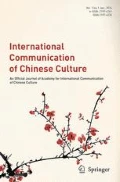Abstract
The Opium wars epitomize a crucial moment in Chinese history, a turning point that globally affected all countries involved, the Qing dynasty and the Western powers, which witnessed radical political, economic and social changes both internally and in their international relations. Recognizing that orientalism with its corollary of studies, researches, travel impressions, beliefs, stories, and popular gossips about China and the Orient in general, is a pervasive form of knowledge which has a political nature, means agreeing on the fact that the Western knowledge upon the Orient has been an agency for the action that has followed, namely imperialism and colonialism, which in turn led to the Opium wars. Geography became the scientific side of such knowledge. As a matter of fact, the moment in which geography embraced the cold geometries of cartography, it turned into a tremendous support to the knowledge process pertaining to the Orientalism. A process driven by mere political and commercial interests, and deceitfully expressed in the popular culture of those Western societies and countries which supported and had colonies in the Far East.
Similar content being viewed by others
References
Claudio, Minca, and Bialasiewicz Luiza. 2004. Spazio e Politica Riflessioni di Geografia Critica. Padova: CEDAM.
Giuseppe, Dematteis. 1985. Le Metafore della Terra. La Geografia Umana tra Mito e Scienza, Feltrinelli, Milano.
Karl, Rebecca. 2001. The Burdens of History: Lin Zexu (1959) and “The Opium War” (1997), In Xudong, Zhang, ed. Whiter China, Durham: Duke University Press.
Marie-Laure Ryan. 2002. Beyond Myth and Metaphor: Narrative in Digital Media. Poetics Today (2002) 23 (4): 581–609. https://doi.org/10.1215/03335372-23-4-581.
Marcel, Danesi. 2007. The Quest for Meaning: A guide to Semiotic Theory and Practice. Toronto: University of Toronto Press.
Mitchell, Timothy. 1988. Colonizing Egypt. Cambridge: Cambridge University Press.
Roland, Barthes. 1957. Mythologies. New York: Farrars, Staus and Giroux, The Noonday Press.
Said, Edward W. 1994. Culture and Imperialism. New York: Vintage Books.
Said, Edward. 1978. Orientalism. Abingdon: Routledge & Kegan Paul.
Author information
Authors and Affiliations
Corresponding author
Rights and permissions
About this article
Cite this article
Cimino, A.M. Cartography and orientalism in late imperial China. Int. Commun. Chin. Cult 7, 395–406 (2020). https://doi.org/10.1007/s40636-020-00187-w
Received:
Revised:
Accepted:
Published:
Issue Date:
DOI: https://doi.org/10.1007/s40636-020-00187-w



